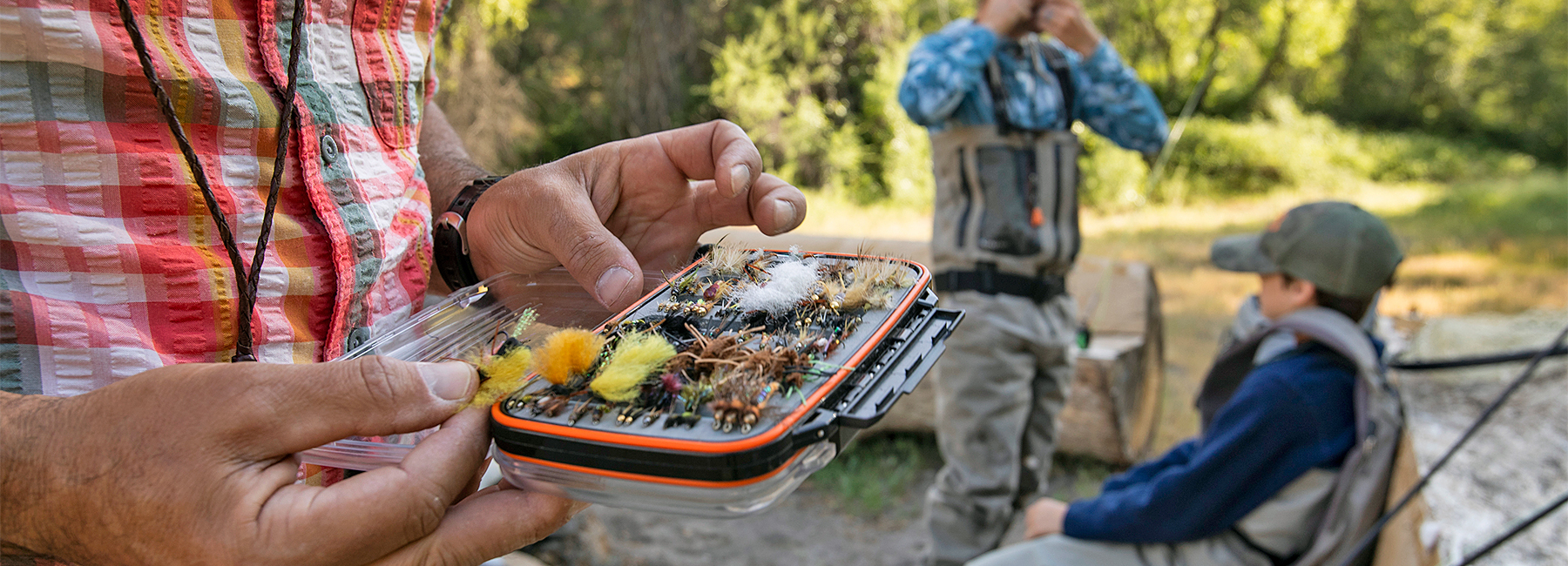Top Five Flies for Fly Fishing Northern California
By Bryan Quick
We are often asked, “What is your favorite fly?” This can be a long discussion leading down riffles and tailouts into the fly fishing abyss. With so many great patterns out there, it is always a tough question to answer, and it begs the question, “Why limit yourself to one pattern?”
The truth is, day in and day out, we find ourselves using the same patterns because they work. Some are versatile, and others mimic trout food found abundantly throughout the Northern California stream watersheds. And, without a doubt, we can’t walk out of The Fly Shop® with every pattern you think you might need for a day on the water. Believe us when we tell you it’s been tried. So, okay, you have pinned us down. Here are our top five fly patterns for Northern California:
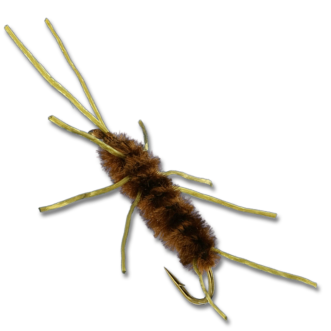 Pat’s Rubberlegs
Pat’s Rubberlegs
In black or brown, size #10 to #6, you better have at least half a dozen when you fish up here. High-sticked on the Upper Sacramento, this fly has probably caught more rainbow trout than most other patterns combined. If you open your box on any stretch of Battle Creek and you don’t find any, you could be out for a nice day of hiking. Any day on the Trinity or Klamath Rivers it is highly likely this fly will be the top producer.
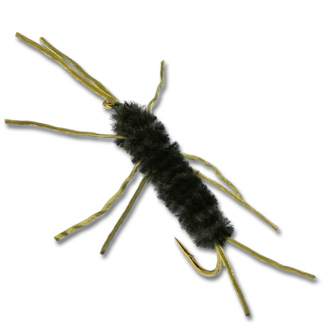 This simple fly with the stretchy, gangly legs, antennae, and tails comprises just five ingredients – a hook, thread, wire, chenille, and Superfloss strands – and is a morsel trout can’t leave alone. With all of the stoneflies, salmonflies, goldens, and skwalas in our streams, it is no wonder trout clobber Pat’s Rubberlegs to the exclusion of other more numerous offerings. This is the drifting, swung T-bone steak of a trout’s diet. Enough said.
This simple fly with the stretchy, gangly legs, antennae, and tails comprises just five ingredients – a hook, thread, wire, chenille, and Superfloss strands – and is a morsel trout can’t leave alone. With all of the stoneflies, salmonflies, goldens, and skwalas in our streams, it is no wonder trout clobber Pat’s Rubberlegs to the exclusion of other more numerous offerings. This is the drifting, swung T-bone steak of a trout’s diet. Enough said.
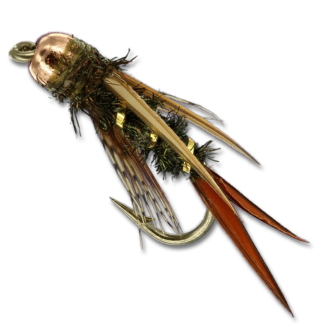 Gordon’s Amber Wing Prince Nymph
Gordon’s Amber Wing Prince Nymph
This attractor fly pattern works for a lot of reasons including faith. When Fred Gordon reimagined the simple Prince Nymph with amber goose biots replacing the white wings of the original, a legendary fly was created. Beaded or not, this fly has a lot going for it with peacock herl, a buggy profile, and throat hackle sporting some movement near the front that activates the appetite of the tiny trout’s brain.
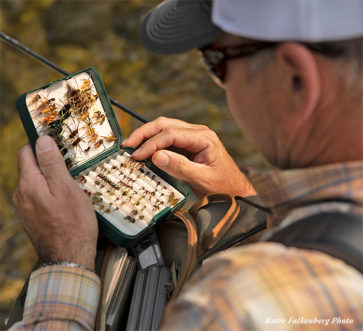 Size it for the small brachycentrus caddis, the small black “Mother’s Day” caddis that come off in droves in the late winter and early spring, and you have a fly that can be dead drifted in runs or swung in tailouts all day long. Later in the summer when the larger hydropsyche caddis proliferate, jump up one or two sizes for the same effect. On spring creeks such as Hat Creek or Fall River, just about any size can be swung to replicate the numerous caddis species and scuds found there. On the Trinity River, this can be a go-to offering at any time. Although steelhead are not notoriously picky, this fly has saved many days over the hill from Redding on the Trinity.
Size it for the small brachycentrus caddis, the small black “Mother’s Day” caddis that come off in droves in the late winter and early spring, and you have a fly that can be dead drifted in runs or swung in tailouts all day long. Later in the summer when the larger hydropsyche caddis proliferate, jump up one or two sizes for the same effect. On spring creeks such as Hat Creek or Fall River, just about any size can be swung to replicate the numerous caddis species and scuds found there. On the Trinity River, this can be a go-to offering at any time. Although steelhead are not notoriously picky, this fly has saved many days over the hill from Redding on the Trinity.
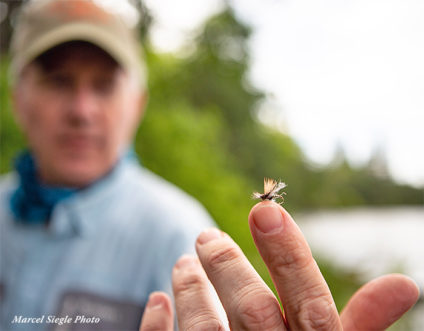 Mercer’s Missing Link
Mercer’s Missing Link
With so many varied hatches coming off during the different seasons and locations, you could fill several boxes with the specific dries you’d need to cover every situation when it comes to targeting rising fish. Fall River guides are notorious for this and spend many hours just purchasing the materials they will use to produce their arsenal for the coming season. Sometimes, however, you happen upon a unicorn, and Mike Mercer’s Missing Link is the Swiss army knife of dry flies.
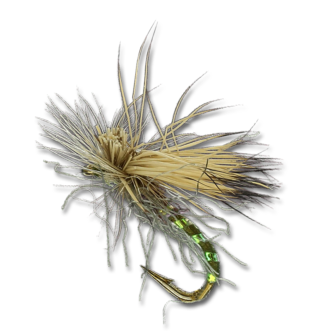 Initially designed to fool the Lower Sacramento River rainbow trout chowing on spent caddis, it turns out this elk haired, z-lon-winged, sparse dry works in many more situations unimagined by the fly tying legend. Placed in front of a San Juan rainbow eating carpenter ants in July is a chef’s kiss. Thrown in front of cruising fish looking for terrestrials on a lake or pond, the Missing Link excels. And, of course, matched in size and color with a current mayfly or caddis hatch, you will have a great day. At bare minimum, you should have half a dozen dark Missing Links in sizes #14-18 in your possession when heading out to fish, and that’s the honest truth.
Initially designed to fool the Lower Sacramento River rainbow trout chowing on spent caddis, it turns out this elk haired, z-lon-winged, sparse dry works in many more situations unimagined by the fly tying legend. Placed in front of a San Juan rainbow eating carpenter ants in July is a chef’s kiss. Thrown in front of cruising fish looking for terrestrials on a lake or pond, the Missing Link excels. And, of course, matched in size and color with a current mayfly or caddis hatch, you will have a great day. At bare minimum, you should have half a dozen dark Missing Links in sizes #14-18 in your possession when heading out to fish, and that’s the honest truth.
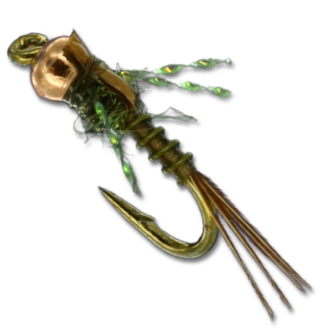 Hogan’s Olive S&M Mayfly Nymph
Hogan’s Olive S&M Mayfly Nymph
Over the years many major studies have been commissioned and conducted to determine the trout’s diet. These have concluded many things, chief among them are that trout will eat what is prevalent, abundant, and available. As any guide up here in the north state will tell you, we have a ton of baetis or blue wing olive mayflies in our streams, and it is just common sense that fish will be eating baetis nymphs on any given day. With its crinkly legs and spare abdomen, Hogan Brown designed a fly that will always produce fish no matter how much you hate to tie on a small fly.
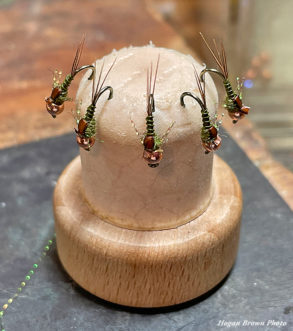 Don’t get us wrong, we will and do set up rigs right off the bat with these flies. In September through January, you will see a steady conveyor belt from the S&M fly bin out the front door of the shop. The S&M has seen service on the deepest indicator rigs, on dry-dropper rigs under Chubby Chernobyl’s, and swung or stripped at the end of an I-line on the Fall River successfully for years. It is rumored, but cannot be confirmed, that a service branch has reached out for a supply of #16 and #18 olive S&M’s to include in their aircrew survival kits. Just saying.
Don’t get us wrong, we will and do set up rigs right off the bat with these flies. In September through January, you will see a steady conveyor belt from the S&M fly bin out the front door of the shop. The S&M has seen service on the deepest indicator rigs, on dry-dropper rigs under Chubby Chernobyl’s, and swung or stripped at the end of an I-line on the Fall River successfully for years. It is rumored, but cannot be confirmed, that a service branch has reached out for a supply of #16 and #18 olive S&M’s to include in their aircrew survival kits. Just saying.
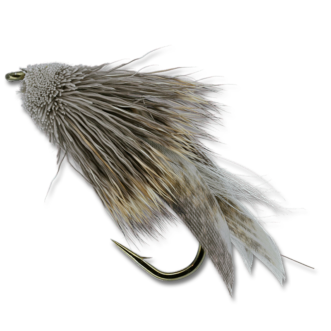 Muddler Minnow
Muddler Minnow
This legendary sculpin pattern almost needs no introduction. Tied in the original style, with the mottled turkey wing and tag, sparse tinsel body, and blocky, clipped deer hair head, this is the jack-of-all-trades, a veritable chameleon in the water. Any tyer claiming the most modest prowess on the vise will have tied some, fished them, and caught fish. What makes this such an indispensable fly up here? Let’s go through some examples.
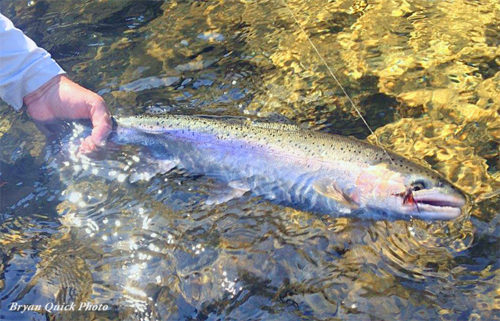 Early in the year, beginning in February, we see actual sculpins in our streams beginning to pair up, and the trout will key in on this as they pop up during their displays. Swung on the end of an I-line or fished with a sinking line, fish will chase and grab them. Later, when grasshoppers emerge and the fish have seen one or two, cast them across your favorite run, dance them across the surface, and see what happens. Later, in August and September, this fly will do wonders to your adrenaline level on the Trinity and Klamath Rivers skated over runs that hold steelhead. And in a pinch, an appropriately size Muddler will substitute for salmonflies, Golden stones, crickets, and, well, you get the idea. Tie or buy a dozen in different sizes, and put them in your box.
Early in the year, beginning in February, we see actual sculpins in our streams beginning to pair up, and the trout will key in on this as they pop up during their displays. Swung on the end of an I-line or fished with a sinking line, fish will chase and grab them. Later, when grasshoppers emerge and the fish have seen one or two, cast them across your favorite run, dance them across the surface, and see what happens. Later, in August and September, this fly will do wonders to your adrenaline level on the Trinity and Klamath Rivers skated over runs that hold steelhead. And in a pinch, an appropriately size Muddler will substitute for salmonflies, Golden stones, crickets, and, well, you get the idea. Tie or buy a dozen in different sizes, and put them in your box.
We have a lot of flies to choose from here in the shop, and there are times when there is a particular bug slaying on the river. And then there are those times on the water when it is difficult to decide which pattern to tie on. We can’t help you there. But, when you are heading out to fish the North State, you will increase your chances of hooking fish if you are carrying these patterns.
